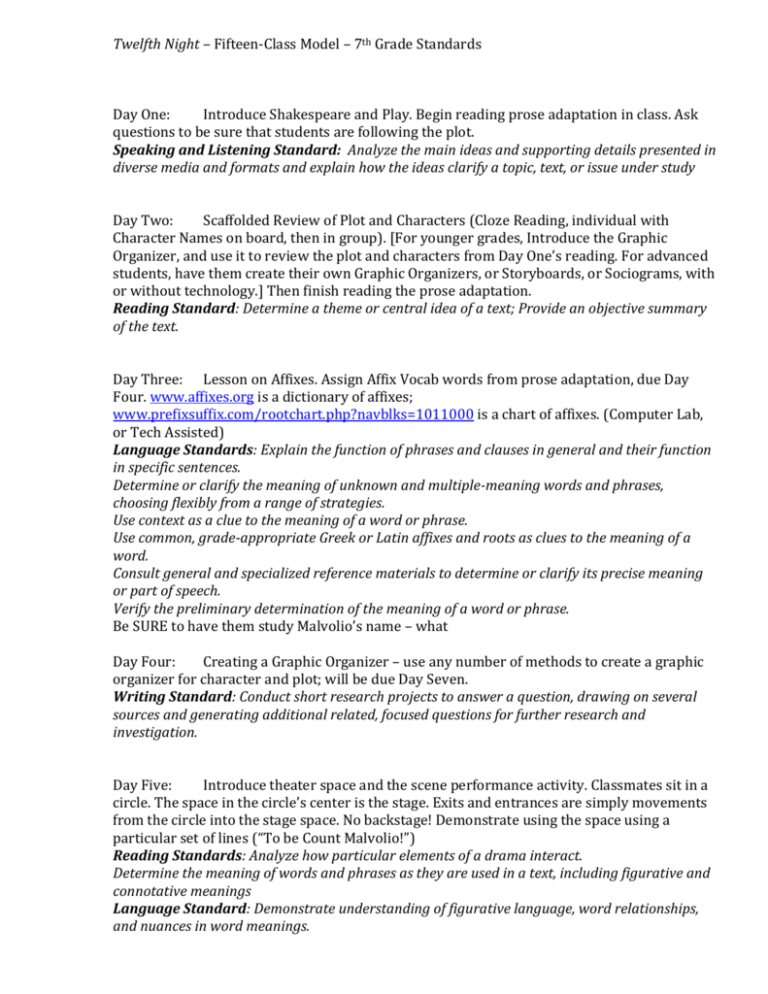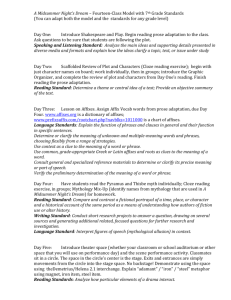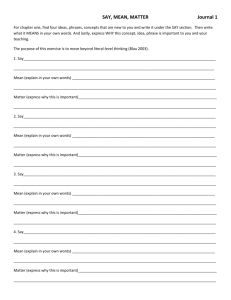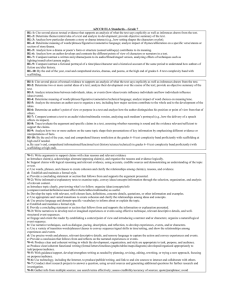Word - Murray State University
advertisement

Twelfth Night – Fifteen-Class Model – 7th Grade Standards Day One: Introduce Shakespeare and Play. Begin reading prose adaptation in class. Ask questions to be sure that students are following the plot. Speaking and Listening Standard: Analyze the main ideas and supporting details presented in diverse media and formats and explain how the ideas clarify a topic, text, or issue under study Day Two: Scaffolded Review of Plot and Characters (Cloze Reading, individual with Character Names on board, then in group). [For younger grades, Introduce the Graphic Organizer, and use it to review the plot and characters from Day One’s reading. For advanced students, have them create their own Graphic Organizers, or Storyboards, or Sociograms, with or without technology.] Then finish reading the prose adaptation. Reading Standard: Determine a theme or central idea of a text; Provide an objective summary of the text. Day Three: Lesson on Affixes. Assign Affix Vocab words from prose adaptation, due Day Four. www.affixes.org is a dictionary of affixes; www.prefixsuffix.com/rootchart.php?navblks=1011000 is a chart of affixes. (Computer Lab, or Tech Assisted) Language Standards: Explain the function of phrases and clauses in general and their function in specific sentences. Determine or clarify the meaning of unknown and multiple-meaning words and phrases, choosing flexibly from a range of strategies. Use context as a clue to the meaning of a word or phrase. Use common, grade-appropriate Greek or Latin affixes and roots as clues to the meaning of a word. Consult general and specialized reference materials to determine or clarify its precise meaning or part of speech. Verify the preliminary determination of the meaning of a word or phrase. Be SURE to have them study Malvolio’s name – what Day Four: Creating a Graphic Organizer – use any number of methods to create a graphic organizer for character and plot; will be due Day Seven. Writing Standard: Conduct short research projects to answer a question, drawing on several sources and generating additional related, focused questions for further research and investigation. Day Five: Introduce theater space and the scene performance activity. Classmates sit in a circle. The space in the circle’s center is the stage. Exits and entrances are simply movements from the circle into the stage space. No backstage! Demonstrate using the space using a particular set of lines (“To be Count Malvolio!”) Reading Standards: Analyze how particular elements of a drama interact. Determine the meaning of words and phrases as they are used in a text, including figurative and connotative meanings Language Standard: Demonstrate understanding of figurative language, word relationships, and nuances in word meanings. Day Six: Issue scripts. Read-around for all scenes. Have students list vocabulary words on a white board or craft/kraft paper. Create a class vocab list from their words – special attention to affixes! Reading Standard: Determine the meaning of words and phrases as they are used in a text, including figurative and connotative meanings; analyze the impact of rhymes and other repetitions of sounds on a specific verse or section of a drama. Language Standards: Explain the function of phrases and clauses in general and their function in specific sentences. Determine or clarify the meaning of unknown and multiple-meaning words and phrases, choosing flexibly from a range of strategies. Use context as a clue to the meaning of a word or phrase. Use common, grade-appropriate Greek or Latin affixes and roots as clues to the meaning of a word. Consult general and specialized reference materials to determine or clarify its precise meaning or part of speech. Verify the preliminary determination of the meaning of a word or phrase. Speaking and Listening Standard: Delineate a speaker’s argument and specific claims, evaluating the soundness of the reasoning and the relevance and sufficiency of the evidence. Day Seven: Read-around continues. Teachers circulate to answer questions. Try to answer questions with questions – get them thinking. Reading Standard: Read and comprehend drama proficiently. Day Eight: Rehearsal. Be sure that students recognize that they do NOT need to memorize. Clarity, Fluency, Comprehension are the goals. Speaking and Listening Standard: Adapt speech to a variety of contexts and tasks, demonstrating command of formal English when indicated or appropriate. Day Nine: Rehearsal. Clarity, Fluency, Comprehension. Reading Standard: Analyze how particular elements of a drama interact. Day Ten: Stop Rehearsals to discuss props and costuming. Keep props and costuming to a minimum – the words and movements are the most important! Then continue rehearsals. Homework: Assessment – what happens in your scene/act? how does your scene/act contribute to the plot of the play as a whole? (Act Blog?) Reading Standard: Compare and contrast a written drama to its staged version, analyzing the effects of techniques unique to each medium. Day Eleven: Rehearsal, with props. Language Standard: Use knowledge of language and its conventions when speaking and listening. Day Twelve: Rehearsal, with props. Language Standard: Use knowledge of language and its conventions when speaking and listening. Day Thirteen: Performance Day. Performance is by classmates, for classmates, for the purpose of seeing, hearing, and understanding the play. Reading Standards: Determine a theme or central idea of a text and analyze its development over the course of the text; provide an objective summary of the text. Analyze how particular elements of a drama interact. Language Standard: Use knowledge of language and its conventions when speaking and listening. Day Fourteen: Playing with the Play – Introduction to the full play – Classroom Book Set – have students find their own scenes and compare/contrast to the complete play. Reading Standards: Analyze how a drama’s form or structure contributes to its meaning. Compare and contrast a written drama to its staged version. Day Fifteen: Constructed Response writing activity. Students may use scripts and/or classroom book sets, depending on standards to be covered in the CR. Reading Standards: Cite textual evidence to support analysis of meaning; make inferences from the text Determine a theme or central idea; analyze its development over the course of the text; provide an objective summary of the text. Analyze how a drama’s form or structure contributes to its meaning. Analyze how an author develops and contrasts the points of view of different characters. Compare and contrast a written drama to its staged version, analyzing the effects of techniques unique to each medium Writing Standards: Write arguments to support claims with clear reasons and relevant evidence (a-e). Further Writing Activity: Write a creative fiction narrative from the perspective of one of your characters in one of your scenes, or between two scenes. What is your character thinking, or doing? Develop as thoroughly as possible. Writing Standard: Write narratives to develop real or imagined experiences or events using effective technique, relevant descriptive details, and well-structured event sequences (a-e). The standards mentioned here are not exhaustive; others may be built into the unit easily.






